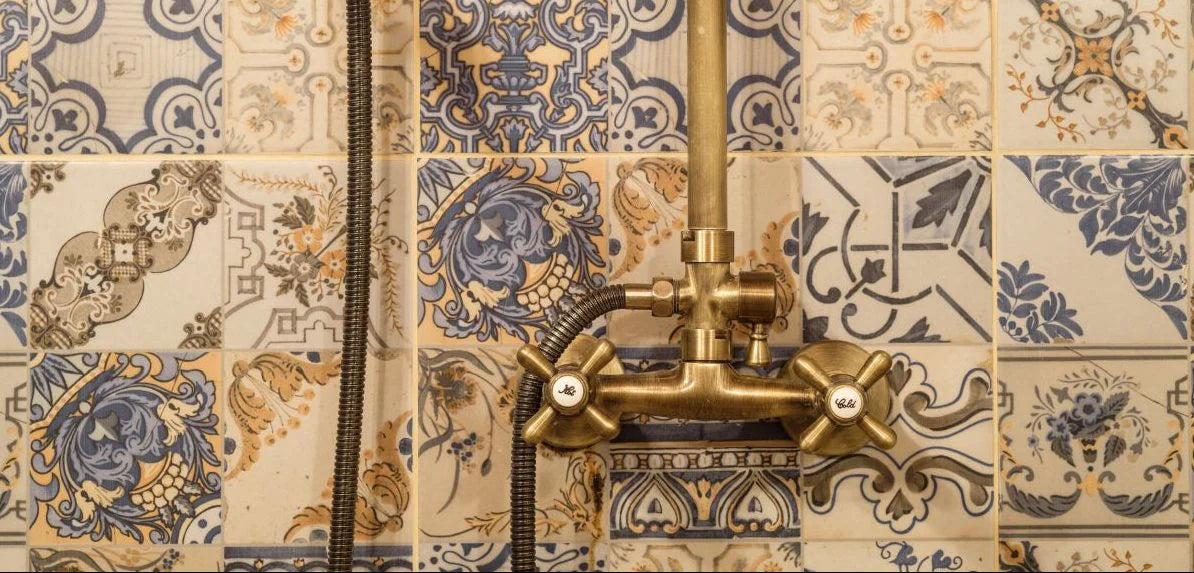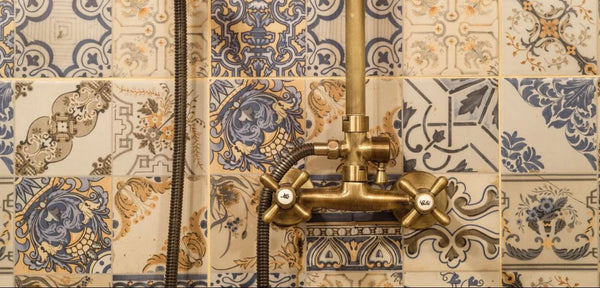Copper is extremely popular in modern interior design because it lends itself well to cool elegance of Scandinavian minimalism, yet also supports a rustic, farmhouse-inspired vibe. The colors range from a reddish, brassy tone to hints of pink or yellow for a more gold-inspired hue.
And it’s easy to use copper in the bathroom, from installing new sink faucets to exposed industrial piping. In fact, with so many options, it can be hard to choose how can you want to incorporate copper in the space. Follow these design tips to use this metal in your home bathroom, no matter what the style or design.
Introduction to Copper
If your chrome and silver fixtures feel drab or boring, copper may be just what you’re looking for. Copper is more unique than these traditional elements, adding depth and warmth to the bathroom. Plus, it brings “real luxury and impact” to the space, says textile designer Nancy Straughan.
When considering copper, it’s important to know the many different styles and varieties available. The four main finishes are mechanical, chemical, protective coatings and laminated, according to the Copper Development Association, Inc. Mechanically-finished copper surfaces are popular in the bathroom because they come in an infinite number of patterns and textures, allowing for true personalization.
The hammered copper vessel sink featured in an RV bathroom remodel at the Joyfully Glowing blog shows just one way that the material can be textured. Here, the dark metal pops against the white elements used throughout the rest of the space.
Copper naturally oxidizes, creating a film on its surface called patina, Amanda Sims at Architectural Digest writes. Patina creates an old-world charm, and a repeated application of vinegar, ammonia and salt can be speed the patina process, until the desired appearance is achieved.
The metal boasts a number of practical benefits for the home. The first is that it’s naturally antimicrobial. “Copper has been proven to kill 99.9% of bacteria within 2 hours and stop many other bacteria from multiplying,” the Heritage Bathware team writes in an article at design inspiration business Home Ideas. This makes copper a particularly great choice for homes with children, who tend to carry germs home from school. Bathrooms frequently used by seniors or guests would also benefit from this naturally germ resistant material.
A second important benefit of copper is that it is easy to clean and maintain. Copper can be cleaned without chemicals, interior decorator Leah French points out. Its finish, and whether it is lacquered or not, plays a role in how the copper should be cleaned. Plain copper can be rigorously cleaned, but the same cleaning can ruin the finish on a lacquered piece.

Copper Light Fixtures
Copper has a bold, sophisticated beauty that makes it great for design statement pieces. A copper light fixture, for example, can add a fresh brightness to a space. There are many types of light fixtures, including polished globes, vintage-style cage lights and industrial wirework fixtures, explains the team at Mira Showers UK, a provider of showers, taps and accessories. Hanging copper lights work particularly well for adding drama to a bathroom, because the copper draws the eye upward.
A copper shade on a hanging light can also help a bathroom achieve major vintage vibes. These hanging lights, featured by House Beautiful’s Olivia Heath, will brighten a bathroom of any size. The same style can also be used in pairs above a sink to accompany a double vanity and create warm glow when reflected in the mirror.
Copper is wonderful at reflecting light. This makes copper light fixtures a strong choice for people looking to brighten a bathroom, real estate writer Tara Mastroeni notes. The metal reflects existing natural, artificial and ambient light. For this reason, copper is a good choice for bathrooms where there isn’t a lot of natural light.
Copper Sink and Shower Fixtures
Copper bathroom fixtures combine form and function, and there’s no better example of this than exposed copper pipes. By showcasing pipes traditionally hidden behind a wall, for example, you add warmth to a modern space, Nancy Mitchell at Apartment Therapy writes. Exposed fixtures can also be used to add a more rustic vibe to a space, especially if you’re in search of a shabby chic or farmhouse style.
Copper shower fixtures have also grown in popularity in recent years. As tech writer Marcee Wardell explains, copper shower fixtures can be mixed and matched with a number of other finishes. These include matte black and oil rubbed bronze, but copper on copper bathrooms also work for homeowners who want to create more synchronicity in their design.
For the sink, mounted copper fixtures add an industrial, yet farmhouse-like feel in this bathroom by White Cottage Home and Living. Here, the copper faucet and temperature handles compliment the matching copper light fixture. And, these metallic accents are balanced by the high-contrast black and white tile splashed against the back accent wall. This exemplifies how, even though copper is a bold design choice, it can work well with busier patterns.

Materials and Colors That Compliment Copper
Have you ever thought about using copper to create a statement wall? That’s exactly what’s at play in this gorgeous bathroom featured by Modern Masters, which manufactures decorative coatings and paints.
Their copper wall finish can be used in a variety of ways to create a dimensional surface finish. In addition to adding a reflective and luminous quality to the wall, this approach is extremely personalized. Just one or two walls should be adorned, however. Copper is a beautiful bathroom element, but needs to be used in moderation.
Its reflecting and eye-catching nature means that the metal should be paired with the proper materials in order to achieve a balanced look. So what exactly should copper be paired with?
One of the most popular pairings today is marble and copper, as seen in a bathroom created by designer and developer Cameron Ireland. In this space, copper was used throughout three bathrooms in the house to match the retro-inspired lighting pendants hanging in the kitchen. Instead of using real marble for this project, however, he used a less expensive and more versatile slab of porcelain to achieve the same visual effect.
Matte gray materials also work well with copper and create a balanced scheme. Light matte grey hexagonal tiles, copper fixtures and small marble touches come together in sophisticated harmony in a bathroom designed by Amberth Interiors in London. The monochromatic hexagonal tiles on the walls of the bathtub are balanced with the muted colors of the bathroom floor. The pink tones on the floor echo the pink undertones in the copper.
Images by: spaskov/©123RF.com, Sarah Pflug, Olha Kryvosheieva/©123RF.com, okrasyuk/©123RF.com







